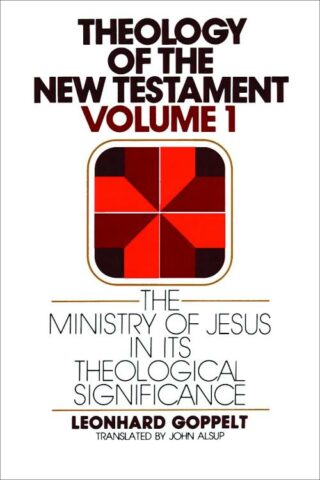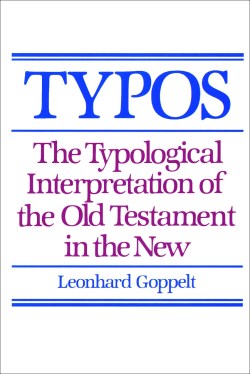Leonhard Goppelt
Showing all 3 resultsSorted by latest
-
Commentary On 1 Peter A Print On Demand Title
$43.99The work of a highly esteemed New Testament scholar, this commentary on I Peter has unparalleled breadth and depth and reflects a lifetime of devoted scholarship. Leonhard Goppelt presents here a rich exposition of I Peter that New Testament students and scholars will consult time and again with great profit.
Goppelt’s detailed section- by-section and phrase-by-phrase commentary is preceded by a complete, up-to-date bibliography and an extended introduction. Scattered throughout the commentary are special notes and excursuses on several themes and issues related to the text of the letter. The footnotes contain a wealth of bibliographical information, which has been updated by translator John Alsup, and an appendix by Alsup provides a brief appreciative survey of the life and works of Leonhard Goppelt. Besides its unusually thorough treatment of the biblical text and the history of interpretation, what distinguishes this commentary is Goppelt’s balanced focus on I Peter as a document setting forth social-ethical guidelines for Christians not just in the first century but in today’s world as well.
A scholarly Christian classic, this monumental commentary on I Peter will find a welcome place in seminary courses (New Testament, social ethics), in theological libraries, and in pastors’ studies.
Add to cartin stock within 3-5 days of online purchase
-
Theology Of The New Testament Volume 1 A Print On Demand Title
$35.99This volume, the first of a two-volume work by Leonhard Goppelt, represents the most mature and comprehensive thought of this German New Testament scholar. Among German-speaking scholars it is distinguished as rivaling, if not replacing, the monumental work on New Testament theology by Rudolf Bultmann.
A study of the life and ministry of Jesus, this volume makes a thoroughgoing application of the most reliable tools and insights of contemporary New Testament scholarship. Goppelt makes a critical examination of the sources for knowledge of the historical Jesus and maintains an ongoing conversation with the views of other interpreters.
Although he sees his study as a “qualified conversation between exegetical and systematic theology,” his goal is always to come to terms with the intent of the New Testament authors without losing sight of Jesus’ meaning for today.
The major themes developed are the coming of the Kingdom of God, repentance and the ethical directives of Jesus, repentance as the gift of God’s Kingdom, Jesus’ ministry of healing and eschatological renewal, Jesus’ self- understanding, and the cross and resurrection.
An appendix provides a history and shows the range of problems in New Testament theology. Here Goppelt also examines and evaluates the historical-critical, historical-positive, and Heilsgeschichtliche approaches. Each chapter includes a detailed bibliography in English and German.
Add to cartin stock within 3-5 days of online purchase
-
Typological Interpretation Of The Old Testament In The New A Print On Deman
$31.99In 1938-39 Leonhard Goppelt finished his doctoral dissertation at Erlangen entitled “Typos: Die typologische Deutung des Alten Testaments im Neuen.” The lasting value of his work was evidenced in 1969 when this dissertation was reprinted, with an appendix on “Apocalypticism and Typology in Paul.” Goppelt’s work has maintained its significance because it deals with biblical hermeneutics – the study of the methodology of biblical interpretation – a subject of renewed interest in the last few years.
In his search for a normative hermeneutics, Goppelt appeals to the New Testament’s interpretation of the Old Testament as a guide. He offers “a study of the interpretation of Scripture that is characteristic of the New Testament” in order to provide a standard guide for interpreting the Bible today. The focal question for Goppelt is how the Old Testament and Jesus Christ are related, and Goppelt’s answer to this question is found in how the New Testament interprets the Old Testament – typologically.
Goppelt begins with a brief survey of the various definitions of typology to determine how it is distinguished from allegory, with which it is often confused. After this introductory chapter, Goppelt divides his work into three parts: Typology in Late Judaism, Typology in the New Testament, and Apocalypticism and Typology in Paul. In his survey of late Judaism, Goppelt examines both Palestinian and Hellenistic Judaism to determine the place of typology in their literatures. Turning to the New Testament, Goppelt looks first at the portrayal of Jesus Christ in the Synoptic Gospels and Acts. Elements of this portrayal are Jesus as the Prophet, as the Son of David and Lord, and as the Son of Man. Goppelt finds each of these characterizations typologically related to the Old Testament. Similarly, in his next chapter on the church as portrayed in the Synoptics and Acts, Goppelt finds a number of typological relationships between the people of God in the Old Testament and the church in the New Testament.
Goppelt next examines the Pauline epistles for Paul’s use of Scripture in general and for his view of Christ and the church. Goppelt here appends brief treatments on 1 and 2 Peter and Jude. In following chapters Goppelt deals with Hebrews, the Gospel of John, and finally apocalypticism and typology in Paul. Here he also examines traditional approaches to the relationship between the Old Testament and the New, the origin and legitimacy of the typological approach, an
Add to cartin stock within 3-5 days of online purchase













